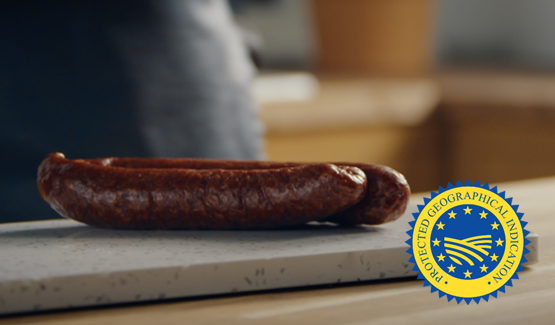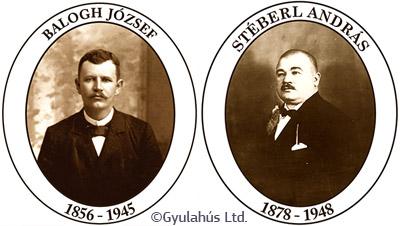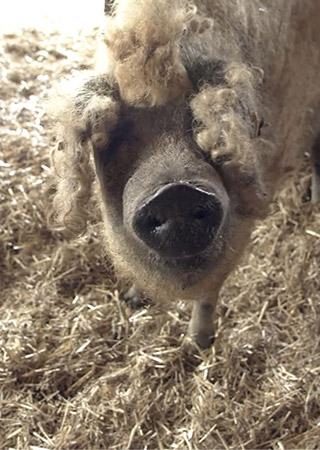
Gyulai kolbász or Gyulai pároskolbász PGI has a pleasantly smoky and spicy fragrance and owes its harmonious flavour and aroma to the blend of spices used. It is sold in pair and should be 18 to 26 cm long, with a label around one of the sausages. It can also be sold in sliced form too.
The rounded flavour and consistency of this award-winning Hungarian sausage truly set it apart.
Origins

Gyulai kolbász or Gyulai pároskolbász PGI is a renowned Hungarian smoked and cured sausage. It is named after the town of Gyula, one of the locations where it is produced, the other being the town of Békéscsaba.

Gyulai kolbász or Gyulai pároskolbász PGI thus originates from the south-eastern corner of the Great Plain, one of the lowest-lying areas of Hungary. The region boasts old traditions of cereal production and animal husbandry, thanks to its mainly moderate continental climate. From the 1880s onwards, this is also where traders going to livestock fairs stopped over for a brief rest. Butchers and slaughtermen seized the chance to lay the foundations of the towns’ future meat processing industries.

By the early 20th century, master butchers had gained considerable expertise. One of them was József Balogh Jr., thanks to whom this sausage won its first international prize in 1910. However, András Stéberl, who in 1912 was József Balogh’s apprentice in the large family business, played a key role in mechanising the production. In 1935, it was his turn to take his products to an international fair, where his “small paired Gyulai kolbász” won a gold certificate. András Stéberl founded what became one of the largest meat-processing factories in the region producing Gyulai kolbász or Gyulai pároskolbász and other dried sausage products.

Gyulai kolbász or Gyulai pároskolbász obtained the European protected geographical indicators (PGI) designation in 2010. Over one hundred years of national and international awards attest to the reputation and quality of this Hungarian speciality:

- Brussels World’s Fair 1910, gold medal, honorary certificate;
- Brussels World’s Fair 1935, gold certificate, honorary certificate'
- Entitlement to use the Kiváló Áruk Fóruma (Excellent Hungarian Product) emblem;
- Foodapest Success Award, 2000;
- Magyar Termék Nagydíj (Hungarian Product Grand Prize), 2001;
- Magyar Minőség Háza (House of Hungarian Quality), 2001;
- Special award for export development, 2001.
The story of Gyulai kolbász or Gyulai pároskolbász PGI highlights the successful combination of century-old traditions with new technology and techniques.
Production

Gyulai kolbász or Gyulai pároskolbász is produced from the chopped meat and firm lard of specific cross-breeds of pigs, including Hungarian Mangalica pigs. Hampshire, Duroc and Pietrain pigs and their hybrids are also used. The meat parts are obtained from the leg, shoulder joint, knuckle, belly, loins, shoulder and collar steak. The production relies on the manual boning method, to remove all the sinews and preserve the quality of the meat.
The first stages of the preparation are carried out mechanically (grinding and stuffing), and call for the main ingredients, the meat and the fat, to be kept cold. To prepare the sausages, the meat parts and lard are minced, before all the essential seasoning is added: a flavoursome combination of salt, sweet and hot ground paprika, garlic, pepper and ground caraway. The resulting paste is filled into casings of pigs’ small intestines in pairs, and the sausages are then clipped at the end. When produced for slicing, the preparation is transferred into vapour-permeable artificial casings. The next stage consists in smoking the sausages, usually over beech wood. This process takes place over a period of two to three days in a relatively humid space.

Finally, the sausages are cured and preserved by drying. Between 14 and 16 days are required for the cure-drying phase. It is followed by a post-maturing stage, during which the moisture content of the packaged product evens out. The antioxidant effect of the natural spices stabilises the colour of the sausages.
Gyulai kolbász or Gyulai pároskolbász PGI sausages should be 18 to 26 cm long. They come in pairs or in sliced form, in which case the casing is removed. They have a slightly bumpy and knobbly surface, a reddish-brown colour, with lard particles showing through. They have a pleasantly smoky and spicy fragrance and owe their harmonious flavour and aroma to the blend of spices used.
More information
Gyulai kolbász PGI – legal specifications

